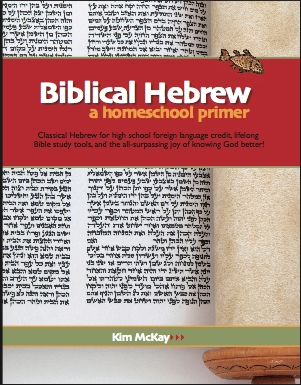Biblical Hebrew: A Homeschool Primer lays the foundation for study of Hebrew by introducing the alphabet, pronunciation, and word formation with beginning translation practice. Since this is more complex than it is in the English language, you might wait until at least upper elementary grade levels to begin unless your child has significant exposure to the language on a regular basis. Lessons in this course also move relatively quickly, making it most appropriate for junior high through adult students. The author recommends it as a one-semester course for high school or a year-long course for younger students.
Essential components are the Biblical Hebrew: A Homeschool Primer book which is the student's worktext and Biblical Hebrew Annotations and Answers which is the teacher's manual. The latter comes with Traditional Hebrew Songs, a CD with recordings of 12 songs that help learners become more familiar with the language. Many of the songs are biblical. One song, “Alef-Bet,” is the Hebrew alphabet song. The Primer includes the Hebrew Songs Copybook section. Here the student completes lessons based on each song on the CD. Primarily through copywork, students become more familiar with the letters, words, and vocabulary.
Students learn a little basic vocabulary in this course, but the goal is more foundational than vocabulary building. Students must first become familiar with the way the language functions—the fact that the alphabet reads right to left, recognition of the letters, how to write the letters, the way vowels points are added to letters to produce different sounds, etc. Students learn new concepts then practice with a variety of written and spoken activities. There's even a Sudoku puzzle in one exercise!
I like the friendly tone and playful attitude of this course that help alleviate some of the intimidation of learning a challenging language. McKay includes some history of languages in general and Hebrew in particular as well as notes on biblical usage that are helpful. Additional information in the teacher's manual might be shared with the students whenever it seems appropriate.
This course might be used as an introduction or supplement to another Hebrew course. It might be used as a part of a unit study on biblical languages. McKay recommends using it in conjunction with Trail Guide to Bible Geography by Wiggers and Wiebe (Geography Matters). McKay recommends many other possible resources to use alongside depending upon the age of the student. Adults and teens might want to use A Reader's Hebrew Bible (Zondervan) so they can actually start to read Scripture in Hebrew. Drive Through History DVDs (Coldwater Media) include one on the Holy Land that might be great for all ages. Ox, House, Stick: The History of Our Alphabet by Don Robb (Watertown) is a children's picture book on the development of language. These and many more suggestions are provided in the teacher's manual.
I highly recommend the optional DVD set, Biblical Hebrew Show and Tell. The two DVDs in this set correlate with the courses lessons, adding fascinating geographical and cultural background. The DVDs also are very helpful for pronunciation. They include pronunciation of the read-aloud sections in the student book as well as vocabulary from each lesson. There are a total of 4.5 hours of viewing altogether on the two DVDs. Students should view the pertinent lesson on the DVD immediately after completing the lesson in the student book.
The Jonah Copybook: An Interlinear Hebrew Translation Workbook is another optional supplement that is very useful. It has the Hebrew words for the complete book of Jonah in boxes with an empty box immediately beneath each word, then a box with the English translation under the blank box. Students can copy the Hebrew word. They should also cover the English and try to translate the text themselves. Since direct translation produces very awkward results, older students should also try to rewrite their own translation in space provided at the bottom of each page. Interestingly, students work through this book from right to left on each page as well as moving from page to page.
While I like this course, occasionally, the explanations could be a little clearer, especially explanations of vowel points. McKay tends to explain only one thing at a time even though what is shown on the page is more complex. For some students, this incremental approach will be fine, while for others it might be frustrating.
In spite of a potential weakness in the explanations, this seems to me a good introductory course, especially for older students. However, I think it important to add that I have not studied Hebrew and have little basis for comparison.








